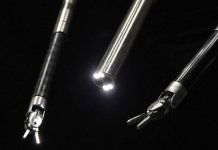
Researchers from the Universities of Melbourne and Manchester have made a groundbreaking advancement in quantum computing technology, introducing a highly purified silicon chip that could significantly enhance the performance and feasibility of quantum computers.
Their findings, published in Communications Materials, mark a major step toward developing quantum computers capable of performing tasks that would take current supercomputers centuries to complete.
At the heart of this development is the electron spin within silicon, used to create quantum bits, or qubits, which are the fundamental units of information in a quantum computer.
Unlike traditional bits, which can be either 0 or 1, qubits can exist in multiple states simultaneously, offering the potential for enormous processing power.
The challenge with qubits is their fragile quantum coherence — the delicate state they must maintain to perform calculations accurately.
Any minor environmental interference, like temperature fluctuations, can disrupt this coherence, leading to errors.
Typically, even in controlled environments as cold as near absolute zero, quantum computers can only maintain error-free coherence for a fraction of a second.
This new technique developed by the team involves implanting phosphorous atoms into crystals of ultra-pure silicon.
This approach enhances the stability of quantum coherence, allowing qubits to maintain their state longer and thus perform complex calculations with fewer errors.
Professor David Jamieson from the University of Melbourne, a co-supervisor of the project, explains that this innovation could dramatically cut down the time required to solve complex problems — from centuries to mere minutes or hours.
This enhanced coherence is key to the practical application of quantum computing in fields like artificial intelligence, secure communications, and pharmaceuticals.
Professor Richard Curry from the University of Manchester adds that their method of creating ultra-pure silicon provides a critical component for scalable quantum computers.
This is achieved by reducing the natural presence of silicon-29 — a variant of silicon that disrupts quantum coherence — from 4.5% to just 0.0002%.
They accomplished this using a standard ion implanter, a device commonly found in semiconductor labs, which they tuned specifically for this task.
The significance of using silicon lies in its compatibility with existing semiconductor technology, which is extensively used in today’s computer chips.
This compatibility suggests that quantum computers could eventually be manufactured on a large scale using familiar techniques, significantly reducing costs and complexity.
Lead author Ravi Acharya points out that their breakthrough not only solves a long-standing purity problem but also sets a new standard for qubit operation, having previously achieved a world record for single-qubit coherence of 30 seconds with less purified silicon.
Looking ahead, the team is focused on demonstrating that their ultra-pure silicon can sustain quantum coherence across multiple qubits simultaneously.
Achieving this would make a quantum computer with as few as 30 qubits more powerful than current supercomputers for certain tasks.
The impact of this research could be profound, with Australia’s CSIRO predicting that quantum computing could generate 10,000 jobs and $2.5 billion in annual revenue by 2040.
This breakthrough by Professors Jamieson and Curry and their teams brings us closer to realizing the full potential of quantum computing, heralding a new era of technological advancement.



